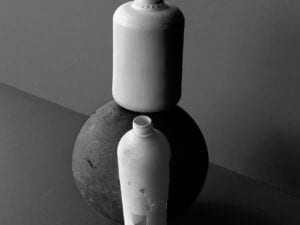Thomas Jenkins is a visual artist working with photographic processes. His work explores colour and abstraction to question what is defined as a photograph in the modern day. His methods stem from interests in contemporary and historical photography, painting and sculpture. The pictures are not intended to be understood but to be felt, experienced and seen. They are an indulgence into colour, which is a fundamental form of visual communication. We ask the Aesthetica Art Prize shortlisted Jenkins to discuss the complex ideas behind his project Chasing Colour and how it’s meant to be viewed.

A: Could you talk a bit about Chasing Colour? How is this personal to you?
TJ: Chasing Colour stems from a multitude of experiences – originally it began as a thought about the complexity of colour and how humans respond to it. The first piece was trying to find a shade of red that ALL people would call red. Describing hues is quite difficult as it can only be done through association. If I ask someone to describe the colour red, they can either respond with “not blue” or by comparison to an external object. I currently view my series as the fundamental basics of seeing. The entire display of rotating triptychs is very personal to me, as creating them is quite a laborious process. I want this reflected in the display. Showing all 50 pieces from the series would be my dream but I understand this requires a large amount of space. I like the idea that everyone could have a different experience viewing the project.
A: Can you please talk through the process of making the piece?
TJ: I try not to discuss the process directly, as it can affect the perceived notion of what the imagery is, which is not necessarily important. What is essential is the colour and how it is experienced. During the creative process, I see myself as someone stealing the essence of materials, reducing them to their visual basis. Making the images is an intensely physical process – the materials themselves often dictate what happens next. This is reflected in the work, which then interacts with the environment in which it’s displayed. The process and the imagery aim to create a discord with traditional photographic methods.
A: What does colour mean to you?
TJ: Colour has infinite means to me, it’s not possible to conceive it, and as mentioned, it is truly difficult to define. Cultural, societal and personal associations warp the meaning of hues to individuals. Whilst we must wrestle with their objective and subjective truths it is wholly mystical. My work is about the incorporeal nature of colour. The inability to hold and touch something we are obsessed with. My practice ultimately stands as an exploration into this mystery and until I have resolved it I will never truly know.
A: What would you like audiences to take away from Chasing Colour?
TJ: Due to the lack of representation in the work, I hope the audiences leave with their own interpretation. I have had many answers to what people see, and each of these is correct. The aim is that viewers experience their own seen or unseen combination and complexity of emotion. Or even just to remember a colour that is so unique that the next time they have to describe it, they will recall Chasing Colour.


A: Could you name some artists who inspire your work?
TJ: I will try to be brief, so first and foremost, photographers Berenice Abbot, Eileen Quinlan and Gary Fabian Miller, painters including Mark Rothko, Gerhard Richter and abstract expressionist artist Lee Krasner. However, the list of names who leave me in awe continues with visual artists, photographers and painters such as Emily Kraus, Francesca Hummler, Melanie Issaka, Nathan Tuttle, Sarabeth Domal and Tom Lovelace. As far as these individuals go, the work and attitudes they display inspire me beyond words.
A: How do you feel about being shortlisted for the Aesthetica Art Prize?
TJ: Having the recognition of Aesthetica is unbelievable. Throughout my years of study, research and practice Aesthetica has constantly had inspiring, engaging and beautiful content which really helped me understand and push my methodology further. To be shortlisted by an organisation that has worked with so many artists who have influenced me is mind-blowing. It’s just an amazing validation. We artists create our works as a means to articulate ourselves. Having something I’ve made, be seen in the gallery and experienced by the public is such a great step in my practice. Chasing Colour – one of my dearest series – being selected for such a prestigious prize is truly inspiring. I really cannot articulate my excitement or gratitude enough – it’s probably something I will have to make an image of, to fully express.
Jenkins features in the Aesthetica Art Prize 2024 Exhibition at York Art Gallery from 16 February – 21 April. Plus, meet over 250 longlisted international artists in our new online gallery.
Want to get involved? The next edition of the Prize is open for entries. Submit your work by 31 August. Win £10,000, exhibition and publication. Find out more here.
All images: Thomas Jenkins, Chasing Colour (2022). C- type print





